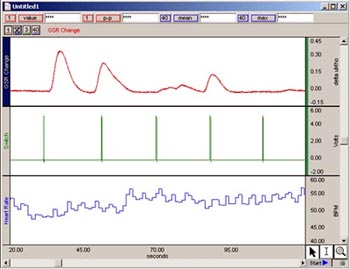H24 Habituation

This experiment will test a subject’s response level while being exposed to a series of pictures with one of the pictures being drastically different and repeated five times over the course of the presentation. The subject should experience habituation, and his/her electrodermal response and heart rate should continually decrease after each exposure to the aberrant image.
Experimental Objectives
- Monitor electrodermal response and heart rate during repeated presentation of a stimulus to demonstrate reduced response.
- Illustrate that habituation is a probabilistic trend toward decreased responding.
Tasks Performed by the Student
- sit in front of computer monitor, relaxed and not moving;and
- watch PowerPoint presentation.
Videos
Biopac Student Lab Student Download
Student Prep & Distance Learning
Click the link(s) below for sample data and/or lesson procedure video(s), BSL PRO Lesson procedures (PDF) for human lessons*, and graph template files (*.gtl) for BSL PRO Lessons. If more than one .gtl is available, download the .gtl with the _suffix to match BSL version and hardware.
Lesson Hardware
This lesson requires a Biopac Student Lab (BSL) System and the following hardware. If your BSL System does not include all hardware items, expand your system by selecting required items below. For more details, review the Lesson: L# BSL Lessons - see the Lab Manual or launch BSL; A# and H# BSL PRO Lessons, click the PDF link above to review full setup, recording, and analysis procedures.
Stay Connected